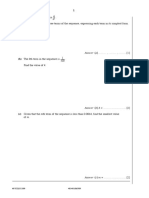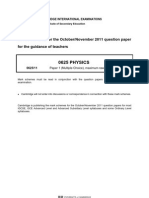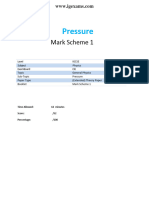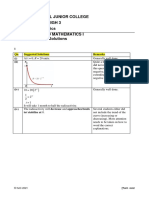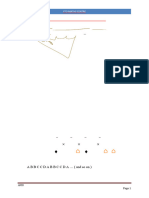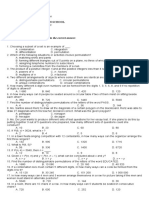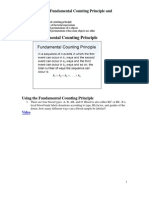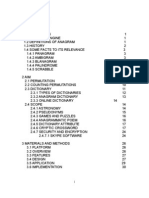Tut 28 POYO & HQ & Supplementary Qns (Solutions)
Tut 28 POYO & HQ & Supplementary Qns (Solutions)
Uploaded by
Lim Kew ChongCopyright:
Available Formats
Tut 28 POYO & HQ & Supplementary Qns (Solutions)
Tut 28 POYO & HQ & Supplementary Qns (Solutions)
Uploaded by
Lim Kew ChongOriginal Description:
Copyright
Available Formats
Share this document
Did you find this document useful?
Is this content inappropriate?
Copyright:
Available Formats
Tut 28 POYO & HQ & Supplementary Qns (Solutions)
Tut 28 POYO & HQ & Supplementary Qns (Solutions)
Uploaded by
Lim Kew ChongCopyright:
Available Formats
Chapter 1 Permutations and Combinations
Tutorial 28: Permutations and Combinations
Practise on your own
1
A delegation of 3 girls and 2 boys is to be selected from a class of 18 girls and 12
boys. Find the number of possible delegations.
Solution:
18 12
Number of possible delegations = 53856
3 2
In a set of 26 cards, each card is marked with one of the letters A to Z so that each
card carries a different letter of the alphabet. Three of these cards are drawn at
random. Find the number of different selections that can be made
(i)
if the cards are drawn without replacement and the order in which the
cards are drawn is disregarded,
(ii)
if the cards are drawn with replacement and the order in which the cards
are drawn is taken into account.
Solution:
26
2600
3
(i)
Number of different selections =
(ii)
Number of different selections = 263 17576
A nursery school has 4 apples, 3 oranges and 2 bananas to share among 9 children,
with each child receiving one fruit. Find the number of different ways in which this
can be done.
Solution:
Number of ways =
9!
1260
4!3!2!
A child was given four boxes of toys. In the first box, there were three identical toy
cars. In the second box, there were four identical toy vans. In the third box, there
were two identical toy motorcycles. In the last box, there was a toy garbage truck.
Find the number of ways in which the child can choose at least one toy from any of
these boxes.
Solution:
3Cars
(4ways)
4Vans
(5 ways)
2MTCs
(3ways)
1Truck
(2ways)
Number of ways child can choose at least one toy
= 5 4 3 2 1 child chooses no toy
= 119
Page 1 of 9
Chapter 1 Permutations and Combinations
A set of 20 students is made up of 10 students from each of two different yeargroups. Five students are to be selected from the set, and the order of selection is
unimportant. Find
(i)
the total number of possible selections,
(ii)
the number of selections in which there are at least two students from each of
the two year-groups.
Solution:
20
(i)
Total number of possible selections = 15504
5
10 10
(ii)
Number of selections = 2 or 10800
3 2
Find the number of 4-letter code-words that can be made from the letters of the word
ADVANCE,
(i)
using neither of the As,
(ii)
using both of the As.
Solution:
2A, 1D, 1V, 1N, 1C, 1E
(i)
5
Number of 4-letter code-words = P4 = 120
(ii)
5
4!
Number of 4-letter code-words = = 120
2!
2
(a)
(b)
Eight people go to the theatre and sit in a particular group of eight adjacent
reserved seats in the front row. Three of the eight belong to one family and sit
together.
(i)
If the other five people do not mind where they sit, find the number of
possible seating arrangements for all eight people.
(ii)
If the other 5 people do not mind where they sit, except that two of
them refuse to sit together, find the number of possible seating
arrangements for all 8 people.
The salad bar at a restaurant has 6 separate bowls containing lettuce,
tomatoes, cucumber, radishes, spring onions and beetroot respectively. John
decides to visit the salad bar and make a selection. At each bowl, he can
choose to take some of the contents or not.
(i)
Assuming that John takes some of the contents from at least one bowl,
find how many different selections he can make.
(ii)
John decides he is going to have 4 salad items, and one of them will
be tomatoes. How many different selections can he make?
Solution:
(a) (i) Number of possible arrangements = 6! 3! = 4320
(ii) Number of possible arrangements = 4320 5! 3! 2! = 2880
Page 2 of 9
Chapter 1 Permutations and Combinations
(b) (i) Number of different selections = 26 1 = 63
5
(ii) Number of different selections = 10
3
8
Eight cards each have a single digit written on them. The digits are 2, 2, 4, 5, 7, 7, 7,
7 respectively.
Find the number of different 7-digit numbers that can be formed by placing seven of
the cards side by side.
Solution:
Case 1: Either digit 4 or 5 are not included
7!
2 = 210
Number of different 7-digit numbers =
2!4!
Case 2: One of the digit 2 is not included
7!
Number of different 7-digit numbers =
= 210
4!
7!
420
Case 3: One of the digit 7 is not included =
2!3!
Therefore, total number of different 7-digit numbers = 210 + 210 + 420 = 840
Challenging Questions
1.
How many rectangles are there in this figure? How many rectangles are there
in an
m x n grid?
[150,
m(m 1)n(n 1)
]
4
Solution:
5 6
Number of rectangles = 150
2 2
m 1 n
1
(m 1)!
(n 1)!
2
(m 1)!(2!) ( n 1)!(2!)
2
m(m 1)n(n 1)
Number of rectangles in an m n grid =
Page 3 of 9
Chapter 1 Permutations and Combinations
2.
The following diagram shows 12 distinct points: a1, a2, a3, b1,, b4, c1,, c5 chosen
from the sides of ABC.
c1
B
c2
c3
c4
c5
b1
b2
b3
b4
a3
a2
a1
(i)
How many line segments are there joining any two of the points on
different sides?
(ii)
How many triangles can be formed? How many quadrilaterals can be formed
from these points?
Solution
(i)
Number of line segments = 5 4 + 3 4 + 3 5 = 47
(ii)
Case 1: 2 points from AB
5
Number of triangles = 7 = 70
2
Case 2: 2 points from AC
4
Number of triangles = 8 = 48
2
Case 3: 2 points from BC
3
Number of triangles = 9 = 27
2
Case 4: 1 point from each side
5
Number of triangles =
1
3
60
1
Therefore, total number of triangles = 70 + 8 + 27 + 60 = 205
(iii)
Case 1: 2 points on two sides
5
Number of quadrilaterals =
2
3 5 4 3
4
108
2 2 2 2
2
Case 2: 2 points on each side and 1 point each on 2 sides
5
4
3
Number of quadrilaterals = 3 4 5 3 5 4 270
2
2
2
Total number of quadrilaterals = 108 + 270 = 378
Page 4 of 9
Chapter 1 Permutations and Combinations
3.
Code numbers, each containing three digits, are to be formed from the nine digits 1, 2,
3, ...,9 . In any number no particular digit may occur more than once.
(i)
How many different code numbers may be found, and in how many of these
will 9 be one of the three digits selected?
(ii)
In how many numbers will the three digits occur in their natural order (ie the
digits being in ascending order of magnitude reading from left to right, eg
359)?
Solution:
9
(i)
Number of different code numbers = P3 = 504
8
Number of required code numbers = 3! 168
2
(ii)
4.
(i)
9
Number of ways = 84
3
n red counters and m green counters are to be placed in a straight line.
Find the number of different arrangements.
(ii)
A town has n streets running from south to north and m streets running from
west to east. A man wishes to go from the extreme Southwest intersection to
the extreme Northeast intersection, always moving either north or east along
one of the streets. Find the number of different routes he can take.
Solution:
n m !
(i)
Number of different arrangements =
n !m !
n 1 m 1 ! m n 2 !
(ii)
Number of different routes =
n 1 ! m 1 ! n 1 ! m 1 !
5.
6.
Find the number of ways the positive integer N can be expressed as a sum of integers,
each of which is 1 or 2, when
(i) N is even and (ii) N is odd.
(J89/MCS/5p)
[The order in which the 1s and 2s appear does not matter. e.g. 1 + 1 + 2 is the same as
2 + 1 + 1 and 2 + 1 + 1 ]
Solution:
N
1
(i) Number of ways =
2
N 1
1
(ii) Number of ways =
2
How many diagonals can be drawn in a pentagon? Generalise the result in the case of
a n-sided polygon.
Number of diagonals in a pentagon 5
A n-sided polygon has n vertices, each vertex has (n 1) diagonal lines.
n 3 n diagonals. Or n n
Therefore, there are
2
2
Page 5 of 9
Chapter 1 Permutations and Combinations
TEMASEK JUNIOR COLLEGE
Supplementary Questions on Permutation & Combination (On Your Own)
(Solutions will be uploaded on Matrix 2.)
1. How many numbers between 10 and 300 can be made from the digits 1, 2, 3, if
(i) each digit may be used only once,
(ii) each digit may be used more than once ?
2. How many combinations of three letters taken from the letters A, A, B, B, C, C, D are
there?
3. A mixed team of ten players is chosen from a class of thirty, eighteen of whom are boys
and twelve of whom are girls.
How many ways can this be done if the team has five boys and five girls?
4. Find the number of ways in which twelve children can be divided into two groups of six
if two particular boys must be in different groups.
5. How many of the permutations of the letters of the word MATHEMATICS do all the
consonants come together?
6. A bridge team of four is chosen from six married couples to represent a club at a match.
If a husband and wife cannot both be in the team, how many ways can the team be
formed?
7. Two sets of books contain five novels and three reference books respectively. How many
ways can the books be arranged on a shelf if the novels and reference books are not
mixed up?
8. A box contains ten bricks, identical except for colour. Three bricks are red, two are
white, two are yellow, two are blue and one is black. How many ways can three bricks
be :
(a) taken from the box
(b) arranged in a row ?
9. How many of the arrangements in a row of all ten bricks in Question 9 are:
(i) the three red bricks separated from each other,
(ii) just two of the red bricks next to each other?
10. In a multiple-choice question there is one correct answer and four wrong answers to each
question. For two such questions, how many ways is it possible to select the wrong
answer to both questions?
11. In Question 10, if a correct answer scores one mark and a wrong answer scores zero, in
answering three such questions how many ways is it possible to score:
(i) 0,
(ii) 1,
(iii) 2?
Page 6 of 9
Chapter 1 Permutations and Combinations
12. A forecast is to be made of the results of five football matches, each of which can be a
win, a draw or a loss for the home team.
Find the number of different possible forecasts, and show how this number is divided
into forecasts containing 0, 1, 2,3,4,5 errors respectively.
(U of L)
13. Find in factor form the number of ways 20 boys can be arranged in a line from right to
left so that no two of three particular boys will be standing next to each other.
(U of L)
14.
Find how many distinct numbers greater than 5000
and divisible by 3 can be formed from the digits 3, 4, 5, 6 and 0, each digit being used at
most once in any number
(JMB)
15. A certain test consists of seven questions, to each of which a candidate must give one of
three possible answers. According to the answer that he chooses, the candidate must
score 1, 2, or 3 marks for each of the seven questions.
How many different ways can a candidate score exactly 18 marks in the test?
(L)
16. A tennis club is to select a team of three pairs, each pair consisting of a man and a
woman, for a match. The team is to be chosen from 7 men and 5 women. How many
different ways can the three pairs be selected?
(U of L)
17. Show that there are 126 ways in which 10 children can be divided into two groups of 5.
Find the number of ways in which this can be done
(i) if the two youngest children must be in the same group,
(ii) if they must not be in the same group.
(U of L)
18. A committee of three people is to be chosen from four married couples.
Find in how many ways this committee can be chosen
(i) if all are equally eligible,
(ii) if the committee must consist of one woman and two men,
(iii) if all are equally eligible except that a husband and wife cannot both serve on
the committee.
(U of L)
19.
Find the number of integers between 1000 and 4000 which can be formed by using
the digits 1, 2, 3, 4
(i) if each digit may be used only once,
(ii) if each digit may be used more than once.
20. How many different ways can the letters of the word MATHEMATICS be arranged?
How many of these arrangements will two A's be adjacent?
Find the number of arrangements in which all the vowels come together.
(U of L)
21. Find the number of different arrangements of the letters in the word PENCILS in which
(i) the E and the I are together,
Page 7 of 9
Chapter 1 Permutations and Combinations
(ii)
the E precedes I (not necessary just precede).
Solutions to Supplementary Questions
1
(i) 2-digit nos. : 3 2 = 6 ,
3-digit nos. : 2 2 1 = 4 ,
Total = 10 ways
Two cases:
(ii) 2-digit nos. : 3 3 = 9
3-digit nos. : 2 3 3 = 18
Total = 27 ways
3
Case 1: all different: = 4
3
3
18 12
5 5
Case 2: 1 repeated : = 9 ,
1 1
Total = 13ways
= 6785856
10
Take the two particular boys out, no. of way to divide 10 boys into two groups =
5
10
2 ]
2 and there are 2 ways to assign the two boys into 2 groups. Ans: 2 [
5
= 252
5
M,T,H,M,T,C,S;
Ans:
7!
5!
2!2! 2!
A,E,A,I
6.
= 75600
5! 3! 2 = 1440
(i) 3 R, 2 W, 2 Y, 2 Blue, 1 Black .
Ans :
4 4
(i)
4
1
4
1
3!
2!
10
Total = 1 + 10 + 16 = 27
(ii)
red
7!
= 240
= 109
_ _ _ _ _ _ _
Ans: 2 ! 2 ! 2 !
3
12 10 8 6
4!
Case 3. 2 same 1 different: = 16 ways
1 1
5
12 ways
10 ways
8 ways
6 ways
Case 2. All different : = 10 ways
3
Case 1. All the same : 1 way
(ii) 1 + 3! +
3
1st member :
2nd member :
3rd member :
4th member :
7!
2 ! 2 ! 2 !
8
2 70560
3
35280
Ans : 4 4 =16
11 (i)
4 4 4 = 64
(ii) 4 4 = 48
1
(iii) 4 = 12 or 1 1
2
Page 8 of 9
Chapter 1 Permutations and Combinations
43
12 no. of errors
no. of ways
5
5
5
5
2 2 10 2 3 10 2 4 10 2 5 10
2
3
4
5
2 10
Total = 243 ways
13
18
3! = 18! 17 16
Ans: 17!
3
14
A no. is divisible by 3 if its sum of all digits is divisible by 3.
Case 1. Use 4,5,6,0
Case 2. Use 3,4,5,0 Case 3. Use 3,4,5,6
5 or
6
2 321
= 12 ways
5 or
6
2 321
= 12 ways
1321
= 6 ways
Case 4. Use 3,4,5,6,0
443 21
= 96 ways
Total = 12 + 6 + 12 + 96 = 126 ways
15
Case 1 5 Questions score 3 marks,
1 Question scores 2 marks
and 1 Question scores 1 mark.
Case 2. 4 Questions score 3 marks,
3 Questions score 2 marks,
0 Question scores 1 mark.
7 2 1
7 3
Ans: + = 77
5 1 1
4 3
16
7
3
5
3 2 1 =
3
19
2100
17
10
2 = 126
(i)
3 3 2 1 = 18
(ii)
3 4 4 4 = 192
(i)
2
2
8
3
= 56
(ii)
(ii)
4
1
4
2
= 24
(iii)
126 56 =
70
18
(i) = 56
3
8 6 4
3!
20
21
11 !
2!2!2!
32
4989600
(i) 6! 2 = 1440
10 !
2!2!
907200 ,
8!
4!
2!2! 2!
120960
(ii) 6! + 5! = 2520
2
Page 9 of 9
You might also like
- SJPO 2018 General Round - Answer GuideDocument18 pagesSJPO 2018 General Round - Answer GuideDivya0% (1)
- A2 Physics DefinitionsDocument5 pagesA2 Physics DefinitionsEjaz YounisNo ratings yet
- CountingDocument2 pagesCountingciupe1No ratings yet
- TOPIC-6A Waves - IgcseDocument19 pagesTOPIC-6A Waves - IgcseSorin PopaNo ratings yet
- BASE Sec 1 - CH 14 - Volume and Surface AreaDocument8 pagesBASE Sec 1 - CH 14 - Volume and Surface AreaJimmy Soleman100% (1)
- IB Physics Exam Style Practice AnswersDocument17 pagesIB Physics Exam Style Practice Answerskarim.ayoubNo ratings yet
- Grade 9 Trigonometry Paper 2 RevisionDocument6 pagesGrade 9 Trigonometry Paper 2 RevisionDiivyaang100% (1)
- ACS2020 6091 Sec 4 Prelim Pract Exam Question PaperDocument14 pagesACS2020 6091 Sec 4 Prelim Pract Exam Question PaperYINJIAYI HOUNo ratings yet
- 31.2-General Wave Popeties-Cie Igcse Physics Ext-Theory-QpDocument12 pages31.2-General Wave Popeties-Cie Igcse Physics Ext-Theory-Qpnityam bajajNo ratings yet
- Homework Week 6Document7 pagesHomework Week 6Rayonesh Rayana100% (1)
- 9702 w17 QP 13 PDFDocument20 pages9702 w17 QP 13 PDFDhito PramudyaNo ratings yet
- E Maths Sec 42011Document267 pagesE Maths Sec 42011Timothy Handoko100% (1)
- Basic Math MST 2122s1 QuestionsDocument4 pagesBasic Math MST 2122s1 QuestionsAlexis SeowNo ratings yet
- SC2 - States of Matter & Mixtures - Edexcel Practice PaperDocument8 pagesSC2 - States of Matter & Mixtures - Edexcel Practice Paperartw2009No ratings yet
- 2011 SJPO Student Handout 25may11Document1 page2011 SJPO Student Handout 25may11Leo Li100% (1)
- Surface Area and VolumeDocument36 pagesSurface Area and Volumetripti aggarwalNo ratings yet
- Yr 9 Algebra ExamDocument2 pagesYr 9 Algebra Examsaavir.aryaNo ratings yet
- Sequences PDFDocument40 pagesSequences PDFPeepee PoopooNo ratings yet
- 5054 w04 QP 1Document20 pages5054 w04 QP 1mstudy123456No ratings yet
- 2017 Math (A) (Sample Past Paper)Document16 pages2017 Math (A) (Sample Past Paper)juliNo ratings yet
- GCSE Exam Questions TrianglesDocument6 pagesGCSE Exam Questions TrianglesAhmed NallaNo ratings yet
- MR - Yasser Elsayed Mobile No: +966451482868 / +201114057545 1Document296 pagesMR - Yasser Elsayed Mobile No: +966451482868 / +201114057545 1tranquil_452889939No ratings yet
- Neltas Topper JiteshDocument7 pagesNeltas Topper Jiteshnishayadav05052012100% (1)
- 4016 Mathematics Topic 1: Numbers and AlgebraDocument7 pages4016 Mathematics Topic 1: Numbers and AlgebraMohammad AshfaqNo ratings yet
- Sparx Crossover AlgebraDocument20 pagesSparx Crossover AlgebraShanaya BanisNo ratings yet
- Upper and Lower Bounds Questions MMEDocument8 pagesUpper and Lower Bounds Questions MMERUDRAKSHI PATELNo ratings yet
- IGCSE Physics WavesDocument8 pagesIGCSE Physics WavesasmatkhanNo ratings yet
- CH 35 FDocument19 pagesCH 35 FrobdebobNo ratings yet
- AA HL-Sequences-Exp-log WS MSDocument46 pagesAA HL-Sequences-Exp-log WS MSDevansh SharmaNo ratings yet
- JCCO 2019 With AnswerDocument5 pagesJCCO 2019 With AnswerbellaNo ratings yet
- 0625 w11 Ms 11Document2 pages0625 w11 Ms 11Shrungar BhuvaNo ratings yet
- 18.1 Pressure CIE IGCSE Physics Ext Theory MsDocument5 pages18.1 Pressure CIE IGCSE Physics Ext Theory Msyousef.abdelazim11No ratings yet
- Cambridge Igcse Chemistry Worksheet - States of MatterDocument5 pagesCambridge Igcse Chemistry Worksheet - States of MatterMohammad Sayed Ali100% (1)
- IGCSE 0580 Mathematics Revision Number MSDocument11 pagesIGCSE 0580 Mathematics Revision Number MSShameed AbdullaNo ratings yet
- Motion in The Universe 1 MS PDFDocument5 pagesMotion in The Universe 1 MS PDFNewton JohnNo ratings yet
- Salt Preparation Worksheet v2Document15 pagesSalt Preparation Worksheet v2Mohammad Motiur RahamanNo ratings yet
- Cambridge O Level: PHYSICS 5054/21Document20 pagesCambridge O Level: PHYSICS 5054/21Fahad A. MalikNo ratings yet
- Practice Paper 2 (1) Mathematics 4024Document15 pagesPractice Paper 2 (1) Mathematics 4024imaad malikNo ratings yet
- Simultaneous Equations QuestionsDocument1 pageSimultaneous Equations QuestionsUzair siddiquiNo ratings yet
- 151.1 Hooke S Law MS CIE IGCSE Physics Practical LDocument6 pages151.1 Hooke S Law MS CIE IGCSE Physics Practical Lafjalnew2020No ratings yet
- Circular Measure Notes 2012Document5 pagesCircular Measure Notes 2012C Dzirutwe100% (1)
- 2021 MA300 Quiz 1 Suggested SolutionsDocument10 pages2021 MA300 Quiz 1 Suggested SolutionsNicholasNo ratings yet
- Third Space Learning Area of A Rhombus GCSE WorksheetDocument13 pagesThird Space Learning Area of A Rhombus GCSE WorksheetForam JivrajaniNo ratings yet
- Yishun Junior College JC 2 Preliminary Examinations 2017 PhysicsDocument25 pagesYishun Junior College JC 2 Preliminary Examinations 2017 PhysicsxiaokiaNo ratings yet
- SJPO 2016 Special Round - Answer GuideDocument26 pagesSJPO 2016 Special Round - Answer GuideZleepNo ratings yet
- CHP 7 PP Pressure W SansDocument11 pagesCHP 7 PP Pressure W SansFrancis Ho HoNo ratings yet
- Mathematics II - BcisDocument2 pagesMathematics II - BcisShiv Shankar SahNo ratings yet
- Edexcel IGCSE Further Pure Mathematics June 2022 Question Paper 1R - 4pm1-01r-Que-20220527Document36 pagesEdexcel IGCSE Further Pure Mathematics June 2022 Question Paper 1R - 4pm1-01r-Que-20220527Kk TtNo ratings yet
- Angle PropertiesDocument8 pagesAngle PropertiesDevil InsideNo ratings yet
- GCSE Questions On VECTORS:, in Terms of A and BDocument7 pagesGCSE Questions On VECTORS:, in Terms of A and BSkyNo ratings yet
- Congruent Shapes and Triangles Third Space Learning GCSE WorksheetDocument17 pagesCongruent Shapes and Triangles Third Space Learning GCSE WorksheetForam JivrajaniNo ratings yet
- Finding The LocusDocument14 pagesFinding The Locusapi-287224366No ratings yet
- Factorial Notation: Type-I: Xi-Mathematics Permutation and Combinations Practice Sheet 1Document9 pagesFactorial Notation: Type-I: Xi-Mathematics Permutation and Combinations Practice Sheet 1joycejoechimNo ratings yet
- STAT 111 Final-Presentation - AwatifDocument400 pagesSTAT 111 Final-Presentation - Awatifr GNo ratings yet
- Practice Interview 8Document30 pagesPractice Interview 8gauri kadyanNo ratings yet
- OpopDocument31 pagesOpopphyo phyoNo ratings yet
- Write The Value of This Expression As A Whole Number. (20 + 40 + 60 + 80 + 100 + 120) - (10 + 30 + 50 + 70 + 90 + 110)Document12 pagesWrite The Value of This Expression As A Whole Number. (20 + 40 + 60 + 80 + 100 + 120) - (10 + 30 + 50 + 70 + 90 + 110)phyo phyo100% (1)
- Year 8-Maths Summer Break HomeworkDocument6 pagesYear 8-Maths Summer Break HomeworkmoezparentNo ratings yet
- Latihan WIMO Chester Grade 1Document49 pagesLatihan WIMO Chester Grade 1Yunita Septriana Anwar100% (5)
- Latihan WIMO Chester Grade 1 PDFDocument49 pagesLatihan WIMO Chester Grade 1 PDFYunita Anwar100% (1)
- Medicine Buddha Sadhana - Drikung KagyuDocument25 pagesMedicine Buddha Sadhana - Drikung KagyuLim Kew ChongNo ratings yet
- ERC 2018 O Level Math P2 Ans Key - v4 Final SMC PDFDocument8 pagesERC 2018 O Level Math P2 Ans Key - v4 Final SMC PDFLim Kew ChongNo ratings yet
- ERC 2018 O Level Math P1 - v4 Final PDFDocument15 pagesERC 2018 O Level Math P1 - v4 Final PDFLim Kew ChongNo ratings yet
- DHE Singhamukha Concise 4 19 14 PDFDocument22 pagesDHE Singhamukha Concise 4 19 14 PDFLim Kew ChongNo ratings yet
- Preliminary Prayers Kusali TsokDocument5 pagesPreliminary Prayers Kusali TsokJochem Meerburg100% (3)
- Mahamayuri NotesDocument1 pageMahamayuri NotesLim Kew ChongNo ratings yet
- Concise Tsok Offering Verse Dudjom PDFDocument2 pagesConcise Tsok Offering Verse Dudjom PDFLim Kew Chong100% (1)
- Dudjom Tersar Ngondro PDFDocument40 pagesDudjom Tersar Ngondro PDFLim Kew Chong100% (2)
- 2015 H2 Promo P1 EditedDocument15 pages2015 H2 Promo P1 EditedLim Kew ChongNo ratings yet
- RI JC1 H2 Maths 2015 Promo QuestionDocument5 pagesRI JC1 H2 Maths 2015 Promo QuestionLim Kew ChongNo ratings yet
- E-Math Formula List - Math (4016)Document9 pagesE-Math Formula List - Math (4016)Lim Kew ChongNo ratings yet
- 01 VA Det MR of H2X AnsDocument3 pages01 VA Det MR of H2X AnsLim Kew ChongNo ratings yet
- X X X Y: Assignment: (To Be Collected in January 2010)Document4 pagesX X X Y: Assignment: (To Be Collected in January 2010)Lim Kew ChongNo ratings yet
- Offering of Butter LampsDocument1 pageOffering of Butter LampsLim Kew ChongNo ratings yet
- Tut 29 POYO (Solutions)Document2 pagesTut 29 POYO (Solutions)Lim Kew ChongNo ratings yet
- 2010 Set B Paper 3 RVHS Promo (Solutions)Document12 pages2010 Set B Paper 3 RVHS Promo (Solutions)Lim Kew ChongNo ratings yet
- Physics Formula List - As at 6 Jul 2011 (Normal)Document4 pagesPhysics Formula List - As at 6 Jul 2011 (Normal)Lim Kew Chong100% (1)
- Tut 30 POYO (Solutions)Document4 pagesTut 30 POYO (Solutions)Lim Kew ChongNo ratings yet
- Marking Scheme Section A: Preliminary Examinations 2009 S4E SC (Physics) Paper 2Document8 pagesMarking Scheme Section A: Preliminary Examinations 2009 S4E SC (Physics) Paper 2Lim Kew ChongNo ratings yet
- Tut 1 APGP POYO (Solutions)Document2 pagesTut 1 APGP POYO (Solutions)Lim Kew ChongNo ratings yet
- Permutations and Combinations - Advanced Questions PDFDocument11 pagesPermutations and Combinations - Advanced Questions PDFnavanshNo ratings yet
- School of Science and Humanities Department of Mathematics: Unit - IvDocument37 pagesSchool of Science and Humanities Department of Mathematics: Unit - IvrlkfjnsdlkNo ratings yet
- Math HL ReviewDocument7 pagesMath HL ReviewLucas Garcia GomezNo ratings yet
- Information Security Assignment QuestionsDocument4 pagesInformation Security Assignment Questionschithrasreemod100% (2)
- Q3 L4 PermutationsDocument2 pagesQ3 L4 PermutationsDarwin CruzNo ratings yet
- Class 11 Maths Notes Chapter 7 Studyguide360Document13 pagesClass 11 Maths Notes Chapter 7 Studyguide360zal adorNo ratings yet
- Q3 W4 LAW Grade 10 Without AnswerkeyDocument2 pagesQ3 W4 LAW Grade 10 Without AnswerkeyMelissa Mae CorongNo ratings yet
- Mathematics: Quarter 3 - Module 2Document15 pagesMathematics: Quarter 3 - Module 2Bryce PandaanNo ratings yet
- Pretest in Math 10 Third QuarterDocument41 pagesPretest in Math 10 Third QuarterRoel SilvaNo ratings yet
- Ch-07 (Permutation and Combinations FINAL 04.01.06)Document26 pagesCh-07 (Permutation and Combinations FINAL 04.01.06)Amit RanaNo ratings yet
- CO34563 Assignment 1Document3 pagesCO34563 Assignment 1kapib57390No ratings yet
- Module 1 - Counting TechniquesDocument125 pagesModule 1 - Counting TechniquesLynde Amor CasayasNo ratings yet
- Mathematics 10: Kauswagan National High SchoolDocument2 pagesMathematics 10: Kauswagan National High SchoolJunard CenizaNo ratings yet
- TLF Papers and ExplanationDocument11 pagesTLF Papers and ExplanationAbhi RamNo ratings yet
- Group Quiz PermutationsDocument76 pagesGroup Quiz PermutationsMr. Rhumer LanojanNo ratings yet
- Fundamental Counting Principle and PermutationsDocument7 pagesFundamental Counting Principle and PermutationsmomathtchrNo ratings yet
- Celtic KnotsDocument199 pagesCeltic Knotscodeethyl100% (3)
- Permutations and Combinations ProblemsDocument4 pagesPermutations and Combinations ProblemschandanNo ratings yet
- 6.S095 Lecture 1 Notes: Basic CountingDocument10 pages6.S095 Lecture 1 Notes: Basic CountingSebastian JeonNo ratings yet
- All-Interval Fractal Sets and The Fibonacci SeriesDocument10 pagesAll-Interval Fractal Sets and The Fibonacci SeriesAntonio Celso RibeiroNo ratings yet
- Master Resource Book in Mathematics For JEE Main 2022 (Prafful K Agarwal) (Iitjeebooks - Com) - Pages-147-154Document8 pagesMaster Resource Book in Mathematics For JEE Main 2022 (Prafful K Agarwal) (Iitjeebooks - Com) - Pages-147-154rishithhr rajeevNo ratings yet
- Permutations and Combinations WorksheetDocument3 pagesPermutations and Combinations WorksheetAmorita GhoshNo ratings yet
- Linear Algebra JournalDocument8 pagesLinear Algebra JournalAzmi Azmi auliaNo ratings yet
- Anagram GenDocument51 pagesAnagram Genvinay999No ratings yet
- Math10 Q3 Wk5 EditDocument11 pagesMath10 Q3 Wk5 EditAnony MousNo ratings yet
- Cse 2006 - Microprocessor and Interfacing Laboratory Manual: Submitted byDocument69 pagesCse 2006 - Microprocessor and Interfacing Laboratory Manual: Submitted byShreyansh Satpathy100% (1)
- Quiz 4.1 (Grade 10)Document1 pageQuiz 4.1 (Grade 10)DanecaNo ratings yet
- 3Rd Grading: GRADE-10 MathematicsDocument131 pages3Rd Grading: GRADE-10 MathematicslouiseNo ratings yet
- Permutation and CombinationDocument2 pagesPermutation and Combinationsampad jashNo ratings yet
- Permutations and CombinationsDocument3 pagesPermutations and CombinationsKaren PianaNo ratings yet

















